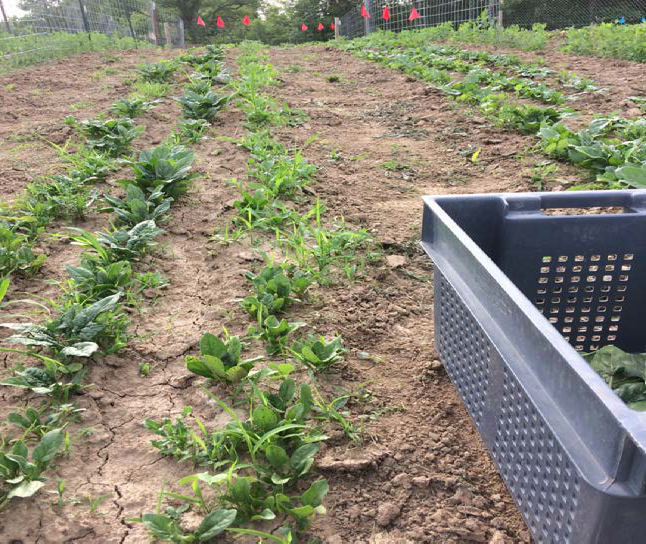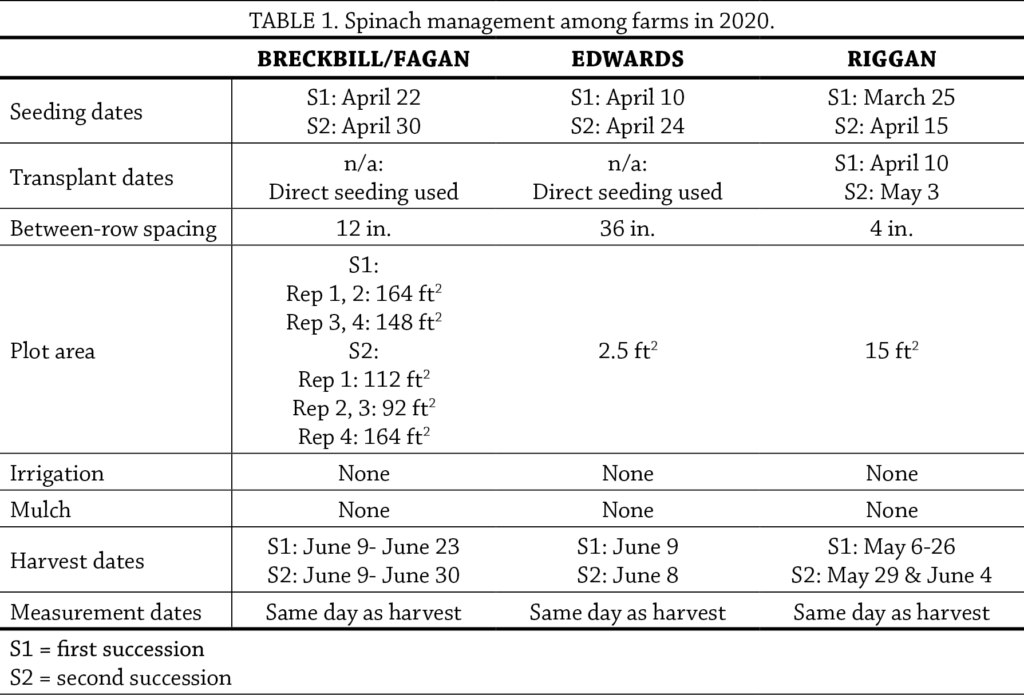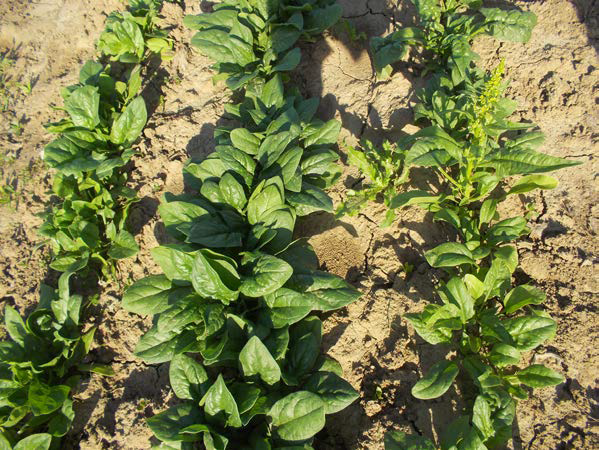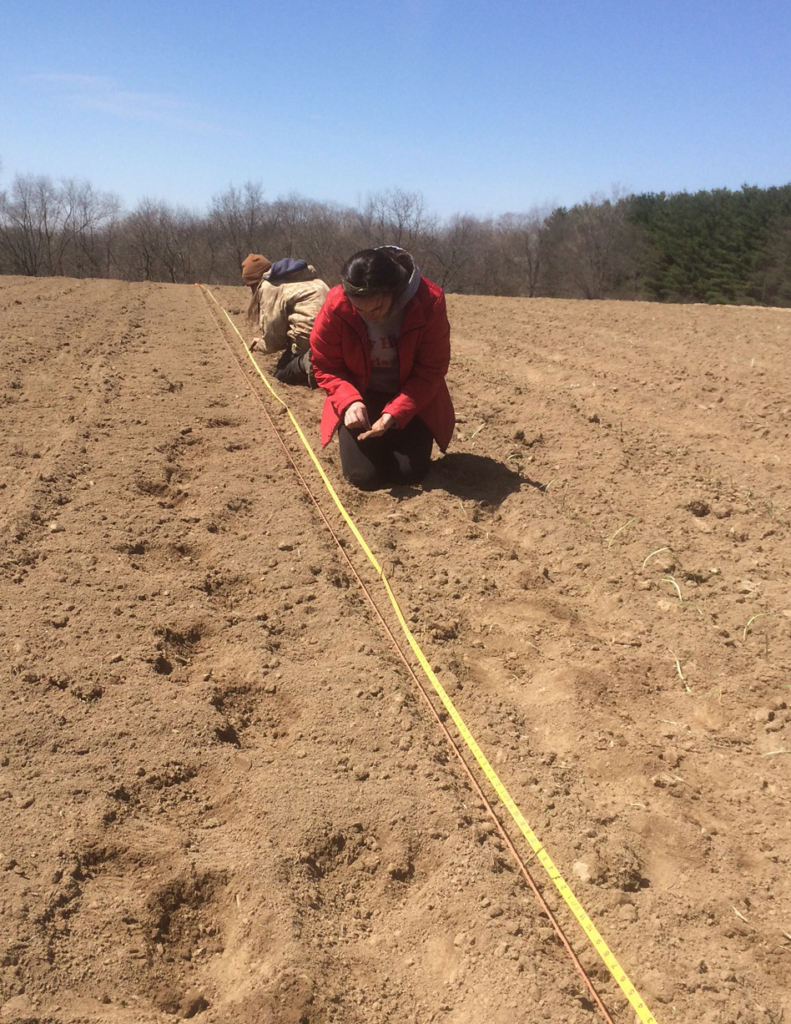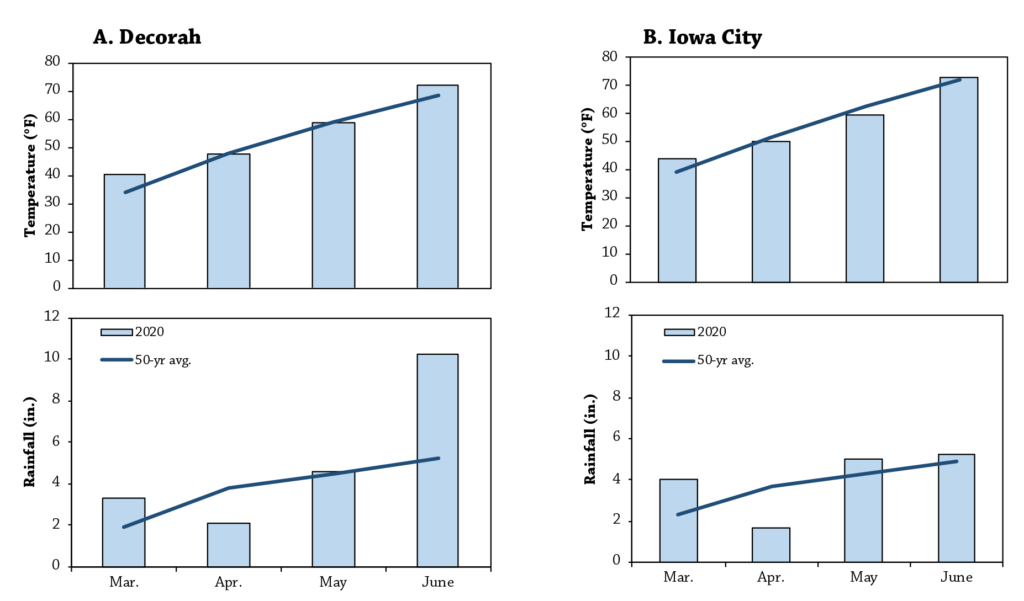This research was funded by Ceres Trust.
In a Nutshell:
- Spinach is a popular cool-season vegetable, so Kate Edwards, Bonnie Riggan, Hannah Breckbill and Emily Fagan wanted to determine which spinach variety (Bloomsdale, Kolibri or Space) grew the best on their farms.
- Cooperators looked for the variety with the highest yield, least bolting, a good flavor, and most loft, or fill in the bag.
Key Findings:
- Kolibri yielded significantly better than Bloomsdale in three of six successions across the three farms.
- Bloomsdale generally had good loft ratings, but also consistently bolted.
Background
Spinach is a cool-season crop that is usually planted in spring or fall. Given the heat-intolerant nature of spinach, it can be difficult to grow, and common issues include bitter taste, low yield, and early bolting, a stress response where the plant diverts resources to seeds and flowers. Spinach is a popular vegetable at farmers markets and in CSA boxes, so farmers look for a variety with high yield, no bolting, good flavor, and lots of loft (high volume and good leaf sitting in a bag). Three spinach varieties are commonly grown in Iowa: Bloomsdale, Kolibri, and Space. Bloomsdale is an heirloom market variety known for good flavor and continuous loft. Kolibri is a semi-savoy variety known for fast re-growth and mildew resistance. Space is an all-season hybrid variety that also has mildew resistance.
Cooperators were curious about which spinach variety would grow best on their farms, by output and quality, to know what to promote at CSAs and early farmers markets. Emily Fagan was very motivated to improve her own practices growing spinach through the trial. “We haven’t had great success with spinach, but it’s something that customers are excited about, so we are hoping to find a variety that will grow well for us,” Fagan said.
Methods
Design
Each farm set up two successions of a randomized, replicated trial, with four replications of each variety. The three varieties trialed were Bloomsdale, Kolibri and Space. Farms could either direct-seed spinach in rows or transplant with a paperpot transplanter at their discretion.
Between March 25 and April 22, cooperators seeded the first succession of spinach either in the greenhouse or the field. Breckbill and Fagan used direct seeding, so no transplant was necessary, and Riggan used a greenhouse, transplanting Succession 1 to the field on April 10. Cooperators seeded the second succession in mid- to late April, with Riggan transplanting to the field in early May. Throughout June, cooperators harvested spinach, recording yield and quality data by plot. Spinach management at each farm is provided in Table 1.
Measurements
At harvest, cooperators weighed produce in the field and scored the plot for bolting and flavor. Bolting was scored as none, some or much. Flavor was scored as unacceptable or acceptable, and later numerical values were substituted as such: “unacceptable” = 0, and “acceptable” = 1. Plot weight was measured in pounds prior to washing. In the field or the packing house, each plot’s harvest was scored for loft. The scoring was none, some or much loft. To create average scoring for quality in bolting and loft, numerical values were later substituted as such: “none” = 0, “some” = 1, and “much” = 2. These quality scores were not statistically analyzed.
Data analysis
To evaluate differences in spinach yield by variety, we calculated Tukey’s least significant difference (LSD). If the difference in yield for any two varieties was greater than or equal to the LSD, we confirm that variety had a statistically significant effect on yield. On the other hand, if the difference in yield was less than the LSD, we consider the varieties to be statistically similar. We used a 90% confidence level to calculate the LSDs, which means that we would expect our rankings to occur nine times out of 10. We could make these statistical calculations for all cooperators due to the replication and randomization of their experimental designs (Figure A1).
Results and Discussion
Plot weight
At Breckbill and Fagan’s, Kolibri performed significantly best in Succession 1, and in Succession 2 both Kolibri and Space performed significantly better than Bloomsdale (Figure 1A).
In Edwards’ trial, Kolibri performed significantly better than Bloomsdale in Succession 1. There was no significant difference in plot weight among the varieties in Succession 2 (Figure 1B). At Riggan’s farm, there was no significant difference found for plot weight among spinach varieties in either succession (Figure 1C). Note that yield differences among the farms is the result of varying plot sizes (Table 1).

FIGURE 1. Spinach plot weight at each cooperator’s farm in 2020. Varieties are listed according to their performance in each succession, with each column representing the succession mean. Results that differ by the least significant difference (LSD) are followed by different letter-ranking and are considered statistically different with 90% certainty. Click to enlarge.
Quality measures
At Breckbill and Fagan’s farm, the Bloomsdale variety had much more bolting than Kolibri and Space did, in both successions. Spinach flavor for all varieties was unanimously acceptable across both successions. Bloomsdale had much more loft in both successions than did Kolibri and Space (Figure 2). Though it yielded least and was most prone to bolting, this loft score means Bloomsdale was more visually appealing for a longer duration than the other varieties.

FIGURE 2. Bolting and loft ratings of spinach varieties at Hannah Breckbill & Emily Fagan’s farm in 2020. We did not
conduct statistical analysis of these ratings. Click to enlarge.
At Edwards’ farm, Bloomsdale also had much more bolting than the other varieties. Spinach flavor for all varieties was unanimously acceptable across both successions. In Succession 1, Kolibri had the most loft and Bloomsdale the least, but in Succession 2 Bloomsdale and Kolibri equally had more loft than Space (Figure 3). Given Kolibri’s performance in plot weight for Succession 1, as well as high loft rankings, this variety appears to be an excellent choice for farmers markets.

FIGURE 3. Bolting and loft ratings of spinach varieties at Edwards’ farm in 2020. We did not conduct statistical analysis of these ratings. Click to enlarge.
At Riggan’s farm, Bloomsdale was the only variety to bolt in either succession. Spinach flavor for all varieties was unanimously acceptable across both successions. For loft, Bloomsdale had unequivocally the most loft in Succession 1, but Space had more in Succession 2. Bloomsdale had no loft in Succession 2 (Figure 4).

FIGURE 4. Bolting and loft ratings of spinach varieties at Riggan’s farm in 2020. We did not conduct statistical analysis of these ratings. Click to enlarge.
Conclusions and Next Steps
Cooperators were curious about which spinach variety would grow the most, bolt the least, and have lasting loft. Kolibri had a significantly higher plot weight than Bloomsdale in three of the six total successions. Bloomsdale not only bolted the earliest, but was the only variety that consistently bolted across the three farms. For quality, Bloomsdale had very good loft at Breckbill and Fagan’s farm, and occasionally had good loft numbers at Edwards’ and Riggan’s farms. Riggan has struggled to germinate Bloomsdale spinach in the past, and this trial confirmed how difficult it is to work with. “Bloomsdale had the best loft, but the drawbacks … make it a tough one to keep in the rotation for production. I might still do it in the winter because the taste is superior, but for spring it’s a no-go on this farm moving forward,” Riggan said at the PFI Cooperators’ Meeting in December 2020.
Cooperators now have the option to pick which spinach variety worked best on their farm, but the trial has left them with other important insights moving forward. Kate Edwards experimented with fencing by succession, and will now fence all spinach. Edwards is also curious about adding new varieties to the trial and trying again. “I … plan to only plant the best variety again and compare it with another variety that I’ve liked in the past and focus on comparing seeding rates,” Edwards said. Riggan learned that her successions were too far apart chronologically, and will move them much closer from now on. Emily Fagan learned more about correctly growing spinach in general. “I learned that we have a little work to do to grow spinach better, aside from choosing the right variety,” Fagan said.


